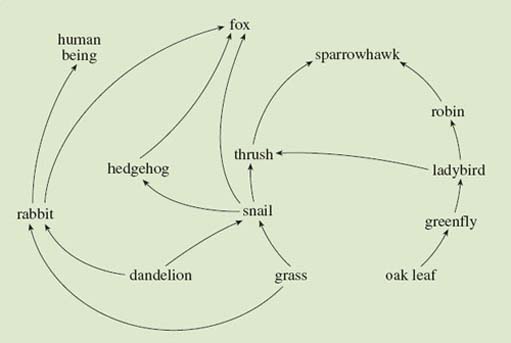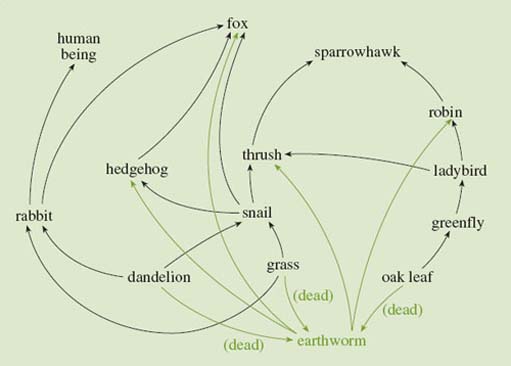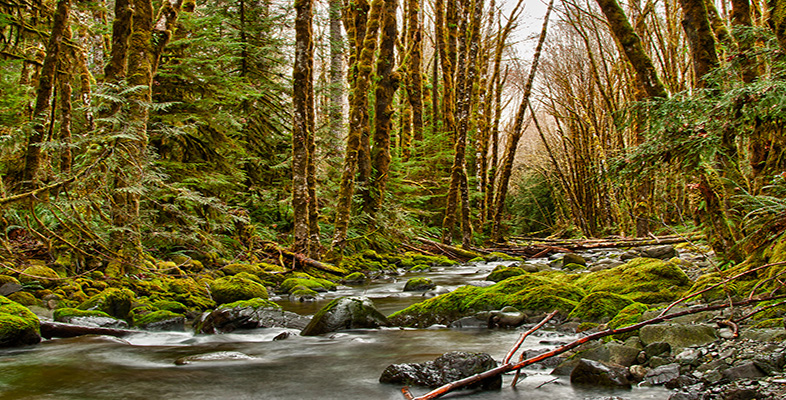6 Mapping interrelationships
Now we have started to identify the components of an ecosystem, living and non-living, we can start to look at ways of describing some of the interrelationships between them. As we have seen, one very direct form of interrelationship involves living things eating other living things. Everywhere we look, we see an animal making a meal out of a plant or another animal.
So, having reduced the biosphere to a manageable ecosystem, and named the organisms involved, we can move on to another pillar of the scientific approach to the natural world: observation.
If we return to our hedgerow and look closely at an oak tree, we might observe caterpillars eating the leaves. These caterpillars will, in turn, be eaten by the robin, and the robin may find itself unlucky enough to feature on the menu of a sparrowhawk.
We could describe these feeding interrelationships in words, as I have done in the paragraph above, but this is a rather cumbersome way of recording the information.
We could write it out in notes like this:
an oak leaf is eaten by a caterpillar is eaten by a robin is eaten by a sparrowhawk
Or we could make it even shorter, like this:
oak leaf → caterpillar → robin → sparrowhawk
When we use a symbol like → it is very important that we are clear about what it means. In this case the symbol → stands for the words ‘is eaten by’. It is important to note the direction of the arrow and to think about what the arrow means.
A diagram like this is called a food chain. It is a very useful way of capturing one important aspect of the interrelationships in an ecosystem.
Activity 7
Food chains
Using a notepad, rearrange the following organisms from Darwin's hedgerow into food chains.
a.thrush … grass … cat … snail
b.sparrowhawk … oak leaf … robin … ladybird … greenfly
c.rabbit … human being … dandelion
d.grass … fox … snail … hedgehog
Answer
a.grass → snail → thrush → cat
b.oak leaf → greenfly → ladybird → robin → sparrowhawk
c.dandelion → rabbit → human being
d.grass → snail → hedgehog → fox
There are some things to remember about food chains.
First, almost all start with a plant that is eaten by an animal. The chains then vary in length, usually from three to five species. The shortest food chains have just two species: for example, blackberry → human being.
The second thing to note is the presence of human beings, ourselves, in some of the chains. We eat a wide range of plants and animals and occur at the top of a large number of food chains. These chains may involve wild or domesticated plants and animals, but almost all the food in your local supermarket is part of a chain that starts with a plant and ends with you.
The third point to note is that several of our food chains have organisms in common. So, for example, grass and snails are common to lists a and d in Activity 7. This is not surprising, as most animals eat a number of different plants or other animals. If some of the food chains in an ecosystem are combined they form a food web, in which each species appears only once. Food webs make it easier to see how the various organisms depend on each other for food. We can combine all the food chains we have produced for Darwin's hedgerow to create the food web shown in Figure 4.

Activity 8
Food webs
Can you add an organism and links to Figure 4 that are not included in our food chains? You may find some ideas in Section 5.
Discussion
My attempt is shown in Figure 5. You may well have come up with a number of different organisms. Food webs can quickly become very complicated: I have added only one organism.

